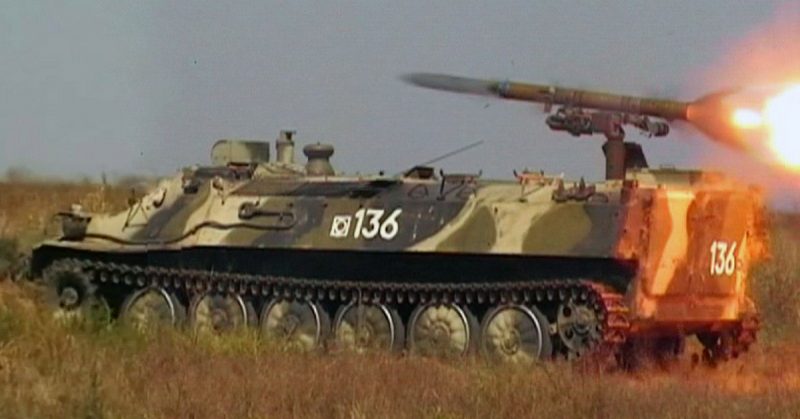In the period following WWII, anti-tank weaponry was very important in warfare. Anti-tank vehicles, which were themselves sometimes mistaken for tanks, became a vital part of military arsenals.
These are the anti-tank vehicles fielded by the Soviet Union during the Cold War.
SU-100
Introduced during WWII, the SU-100 was a relatively simple vehicle. Its 100mm D-10S weapon was adapted from a naval gun. It was elevated and traversed by manual mechanisms. It had no muzzle brake or fume extractor.
The vehicle had no amphibious capability, no night-vision equipment, and no nuclear, biological, or chemical protection. However, if operating far from its base, it could be fitted with four large fuel tanks.
The crew consisted of four men – a driver, commander, gunner, and loader.
A command version was also made, with map boards, radios, and seating instead of the gun.
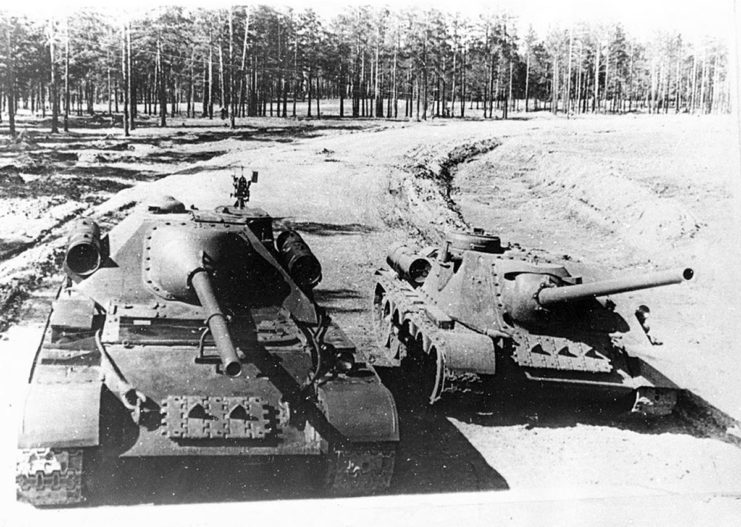
SU-122-54
Design work on the SU-122-54 began in 1949. It went into service in 1954 but was produced for only two years, during which time fewer than a hundred SU-122-54s were made.
The chassis of the SU-122-54 was based on the T-54 battle tank. In place of the tank’s weapons, it had a D-49 122mm gun built into the front. There was also a KPVT 14.5mm machine-gun mounted next to the main weapon, and another KPVT 14.5mm on the loader’s hatch, where it could be used to fire at enemy planes.
ASU-57
The ASU-57 was designed for use by airborne divisions, so it was made as light as possible. Its original steel construction was later replaced with aluminum.
Initially, aluminum containers were made to carry the ASU-57 underneath the wings of planes. Later, as larger planes were produced, it was fitted onto a pallet and transported inside the aircraft, then dropped out of the rear door on a parachute.
The ASU-57 had a Ch-51 or Ch-51M 57mm gun.
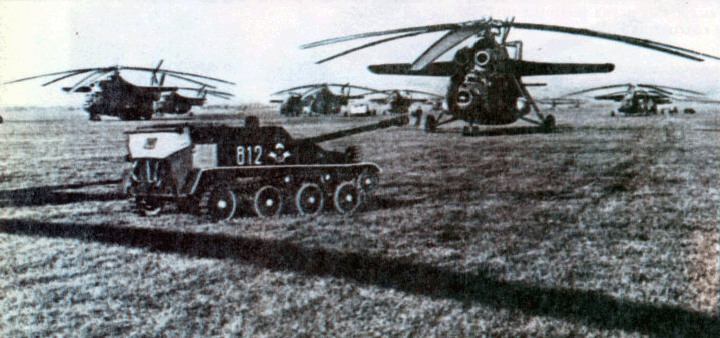
ASU-85
The next step up from the ASU-57 was the ASU-85, which went into production in 1960. It could still be carried by air but was heavier than its predecessor, and so could not be delivered by parachute.
The ASU-85 had a D-70 85mm main gun and a 7.62mm SGMT machine-gun. Later additions included a roof-mounted 12.7mm DShKM machine-gun and smoke grenade launchers that ejected over the hull from the rear.
2P26
The first rocket-equipped anti-tank vehicle, the 2P26 was produced in the late 1950s. It was based on a UAZ-69 light lorry, adapted with launch rails for four missiles.
The missiles were AT-1 Snappers. The Snapper was the first anti-tank guided missile the Soviets developed. Too cumbersome and unwieldy to be carried by infantry, they led to the development of vehicle-mounted anti-tank rocketry. They were controlled by manual commands transmitted down a wire link.
The 2P26 was nicknamed the Baby Carriage.
2P27
The next rocket-based anti-tank vehicle was the 2P27, introduced in 1960. Its chassis was based on that of a combat vehicle; the BRDM-1 reconnaissance vehicle.
The 2P27 used the same AT-1 missiles as the 2P26 with three retractable launch rails fitted inside the vehicle. Before firing, overhead covers and a flap at the rear were opened, then the launch rails were raised.
The 2P27 could not carry spare missiles due to their size.
2P32
The 2P32 arrived two years later and was based on the same chassis as the 2P27. In place of AT-1 Snappers, it carried AT-2 Swatter missiles. They had a smaller wingspan so the vehicle could carry mounts for four instead of three. They were still too bulky to carry spares.
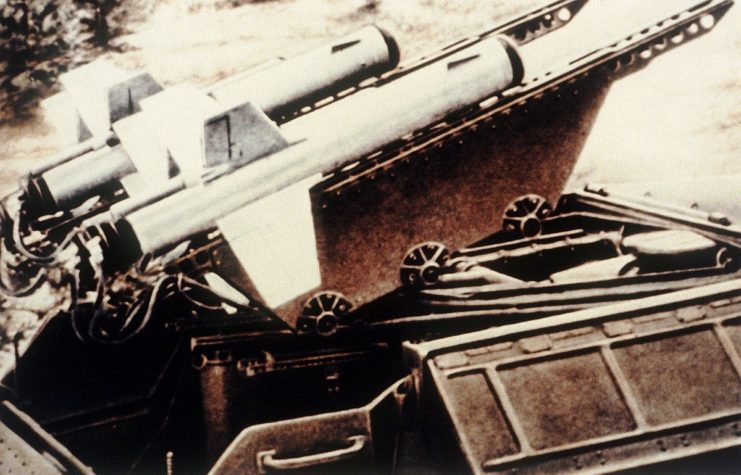
9P110
Introduced in 1963, the 9P110 was another variation on the same vehicle design. Once again, smaller missiles meant that more could be carried. It had mounts for six AT-3 Saggers, as well as eight reloads.
A new mount meant the crew did not have to open armored covers before raising the missiles. As a result, it was much quicker to fire.
IT-1
Built on a T-62 tank chassis, the IT-1 had a pop-up launcher built into a turret. It fired a 3M7 Drakon missile. An autoloader could reload 12 missiles, and three more were carried for manual loading. The turret also had a 7.62mm PKT machine-gun.
The SACLOS guidance system allowed the crew to guide the missiles by radio link. The IT-1 had night vision equipment with a range of 600m. Beyond that range, it was much less useful in the dark.
9P124
Based on the BRDM-2, another reconnaissance vehicle, the 9P124 was equipped with a retractable armored roof. It could be raised to reveal four launchers for AT-2 Swatter C missiles.
The Swatter C had a more sophisticated guidance system, using semi-automatic command and an infra-red link. Four spare missiles were carried for reloading.
9P122
The 9P122 was similar to the 9P124, but with different missiles. This version had six launch rails for AT-3 Sagger missiles. To target the missiles, manual commands to line-of-sight guidance was used.
Like some other missile vehicles of the era, the 9P122 had a remote launch control. The operator could fire the missiles from up to 80 meters away.
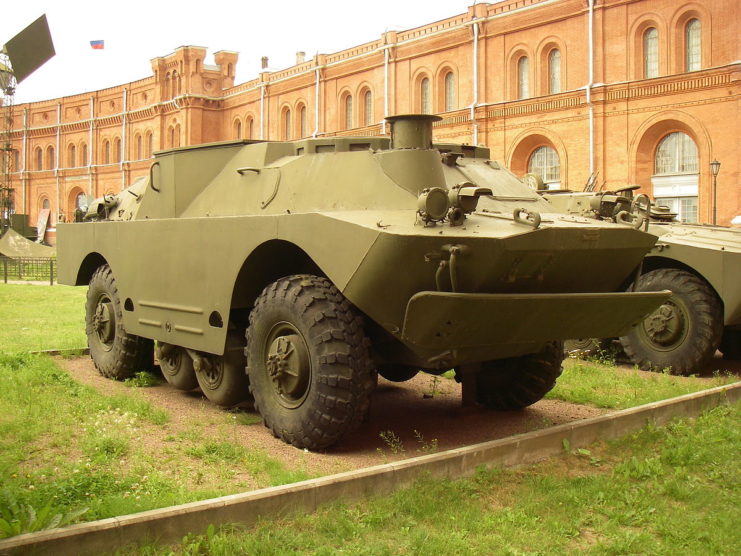
9P148
The 9P148 was a different adaptation of the BRDM-2. The reconnaissance vehicle’s turret was replaced with a mount that fired five AT-5 Spandrel missiles. It could be reloaded by a crewman popping up through a hatch. Ten AT-5s were carried inside the vehicle, allowing two complete reloads.
9P149
Deployed late in the Cold War, the 9P149 was a change from the BRDM-based rocket vehicles. It was instead based on the MT-LB armored personnel carrier. Its retractable launcher fired AT-6 Spiral rockets and had an automated loader carrying 12 of them. The system used a radio link for semi-automatic command of the missiles. It could engage attack helicopters as well as tanks.
Source:
Russell Phillips (2017), Tanks and Combat Vehicles of the Warsaw Pact
